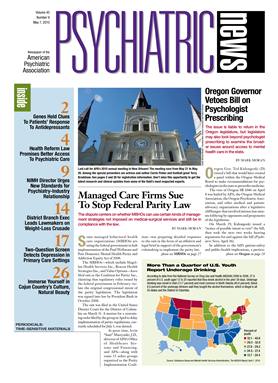All human beings live within some kind of culture—a term that usually encompasses race or religion or geography. Parallel to those lie other cultures. Age cohorts are well-known subcultures and so are professions and workplaces.
“To be a psychiatrist requires cultural awareness,” said Maria Trent-Watson, M.D., a PGY-3 resident in the Department of Psychiatry at the University of Maryland School of Medicine in Baltimore. Over the last 17 years, the program's cultural diversity committee has looked not only at racial and ethnic groups but at those defined by gender, sexual orientation, immigration status, and social class, as well as the special niche in U.S. society of people who have biracial or multiracial identities.
That understanding prompted residents in Trent-Watson's program to choose military culture as this year's theme for its annual Cultural Diversity Day in March.
An anthropologist might describe military culture like any other, noting values, norms, customs, traditions, languages, symbols, and clothing, said Trent-Watson in her introduction.
But there are intangibles, too, as in any culture, said the first speaker of the day, an active-duty military officer with a doctorate in social work.
“Loyalty, commitment, intimacy, cohesion with unit” describe the bonds that hold military people together, explained Lt. Col. Jeffrey Yarvis, chief of the Behavioral Health Service at Walter Reed Army Medical Center in Washington, D.C., and an assistant professor of family medicine and director of social work at the Uniformed Services University of the Health Sciences in Bethesda, Md.
Overall, this shared experience defines members of the group and separates them from nonmembers.
A culture also supports and protects its members. As an example, Yarvis ran a video clip taken in a field hospital in Iraq of an Army captain telling his soldiers that another man in their unit had died of his wounds. The officer is clearly affected emotionally by the loss, but does his best to rally his men to finish their assigned mission while saying, “I'm here for you.” It's a telling display of the modern American military force, where the focus on the mission is mixed with the duty to care for each other.
In general, troops want to go back on duty, even after some traumatic action, said Yarvis. They don't want to let down their teammates. “It may harm them more if they don't complete their mission. So if they say they don't want to go back, it's a red flag.”
Mental health services in the field can be provided at different levels by psychiatrists, psychologists, social workers, chaplains, and trained enlisted personnel.
Sometimes “care” is much less formal, said Yarvis. After-action debriefings by unit leaders serve partly to gather information and partly to vent the emotions generated by a firefight or patrol. “That's when you bring in the social worker or the chaplain, if needed,” he said.
In nonmilitary settings, practitioners should establish if their patients have a military connection, said Yarvis. Either they or a member of their family may be in the Armed Forces and may be facing the stresses of military life or trying to cope with its effects.
“Family members include parents, spouses, siblings, grandparents,” he said. “Any of them may be affected by the experience of their soldier.”
The more inclusive phrase “service member” might even be a better choice than soldier or even veteran, said another speaker, Harold Kudler, M.D., mental health coordinator for the Veterans Integrated Service Network, Number 6, and an associate clinical professor of psychiatry at Duke University. Also, therapists should ask women patients about combat duty, since many have experienced it in Iraq or Afghanistan, he said.
U.S. Army veteran Lorie Morris, Psy.D., now a psychologist at the Baltimore VA, added that therapists should ask patients which military branch they served in, as well as whether their unit had good leadership and support. “Start by asking, 'What was it like where you were stationed?'”
Yarvis has one advantage over civilian and many military therapists: he is a former Armored Corps officer who later earned degrees in social work. In Iraq, he was embedded and went out on patrol with the soldiers.
“You have to be with them to build trust,” he said. “I'm a soldier first, an officer second, and a social worker third.”
For civilian practitioners, trust building may have to come secondhand, but can be learned just as with any other cultural competency.
To be able to discuss and understand patients' military experiences, a clinician with no military background must find a way to bridge the cultural gap and make patients feel safe to talk about what are often traumatic, even horrific, incidents, he said.
Asking if a soldier has killed someone is probably the worst possible opening, said Yarvis.
“Maybe the best way is to ask what your expectations were before you went in,” he said. “What was your job? Were you adequately trained for what you found during deployment?
“Get beyond the 'what-if?' stuff surrounding a specific incident,” he told listeners. “And as with any case where you need help, request supervision from people who have more experience with this population.”
The strains on troops and their families of the last eight years of fighting have been well documented. So has the need for mental health services for many of those who have returned from combat. That need could be filled by civilian mental health practitioners—provided they have a sufficient understanding of military culture.

